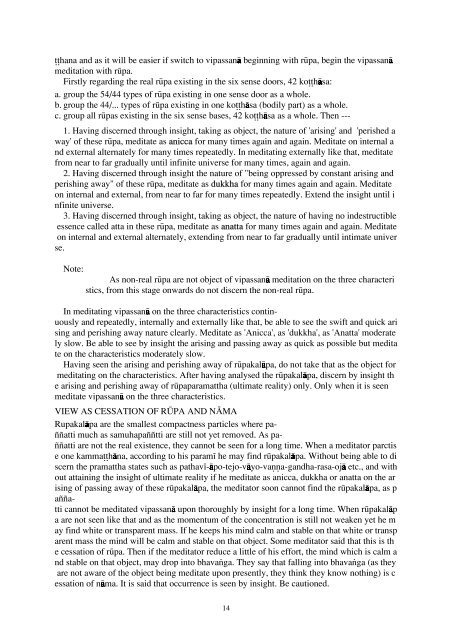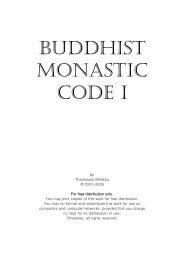Vipassana Kammatthana.pdf
Vipassana Kammatthana.pdf
Vipassana Kammatthana.pdf
You also want an ePaper? Increase the reach of your titles
YUMPU automatically turns print PDFs into web optimized ePapers that Google loves.
hana and as it will be easier if switch to vipassanå beginning with rËpa, begin the vipassanå<br />
meditation with rËpa.<br />
Firstly regarding the real rËpa existing in the six sense doors, 42 ko håsa:<br />
a. group the 54/44 types of rËpa existing in one sense door as a whole.<br />
b. group the 44/... types of rËpa existing in one ko håsa (bodily part) as a whole.<br />
c. group all rËpas existing in the six sense bases, 42 ko håsa as a whole. Then ---<br />
1. Having discerned through insight, taking as object, the nature of 'arising' and 'perished a<br />
way' of these rËpa, meditate as anicca for many times again and again. Meditate on internal a<br />
nd external alternately for many times repeatedly. In meditating externally like that, meditate<br />
from near to far gradually until infinite universe for many times, again and again.<br />
2. Having discerned through insight the nature of "being oppressed by constant arising and<br />
perishing away" of these rËpa, meditate as dukkha for many times again and again. Meditate<br />
on internal and external, from near to far for many times repeatedly. Extend the insight until i<br />
nfinite universe.<br />
3. Having discerned through insight, taking as object, the nature of having no indestructible<br />
essence called atta in these rËpa, meditate as anatta for many times again and again. Meditate<br />
on internal and external alternately, extending from near to far gradually until intimate univer<br />
se.<br />
Note:<br />
As non-real rËpa are not object of vipassanå meditation on the three characteri<br />
stics, from this stage onwards do not discern the non-real rËpa.<br />
In meditating vipassanå on the three characteristics continuously<br />
and repeatedly, internally and externally like that, be able to see the swift and quick ari<br />
sing and perishing away nature clearly. Meditate as 'Anicca', as 'dukkha', as 'Anatta' moderate<br />
ly slow. Be able to see by insight the arising and passing away as quick as possible but medita<br />
te on the characteristics moderately slow.<br />
Having seen the arising and perishing away of rËpakalåpa, do not take that as the object for<br />
meditating on the characteristics. After having analysed the rËpakalåpa, discern by insight th<br />
e arising and perishing away of rËpaparamattha (ultimate reality) only. Only when it is seen<br />
meditate vipassanå on the three characteristics.<br />
VIEW AS CESSATION OF RÚPA AND NÓMA<br />
Rupakalåpa are the smallest compactness particles where paññatti<br />
much as samuhapaññtti are still not yet removed. As paññatti<br />
are not the real existence, they cannot be seen for a long time. When a meditator parctis<br />
e one kamma håna, according to his param¥ he may find rËpakalåpa. Without being able to di<br />
scern the pramattha states such as pathav¥-åpo-tejo-våyo-vaˆˆa-gandha-rasa-ojå etc., and with<br />
out attaining the insight of ultimate reality if he meditate as anicca, dukkha or anatta on the ar<br />
ising of passing away of these rËpakalåpa, the meditator soon cannot find the rËpakalåpa, as p<br />
aññatti<br />
cannot be meditated vipassanå upon thoroughly by insight for a long time. When rËpakalåp<br />
a are not seen like that and as the momentum of the concentration is still not weaken yet he m<br />
ay find white or transparent mass. If he keeps his mind calm and stable on that white or transp<br />
arent mass the mind will be calm and stable on that object. Some meditator said that this is th<br />
e cessation of rËpa. Then if the meditator reduce a little of his effort, the mind which is calm a<br />
nd stable on that object, may drop into bhava∫ga. They say that falling into bhava∫ga (as they<br />
are not aware of the object being meditate upon presently, they think they know nothing) is c<br />
essation of nåma. It is said that occurrence is seen by insight. Be cautioned.<br />
14






